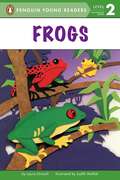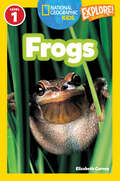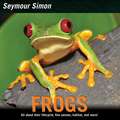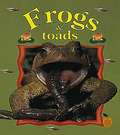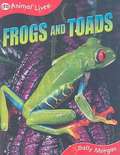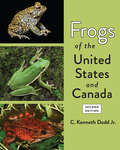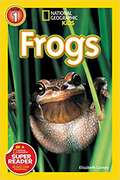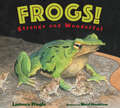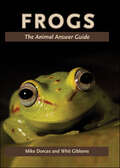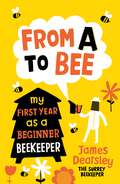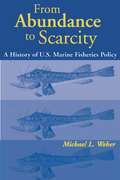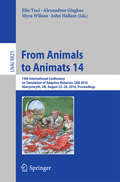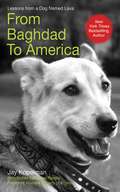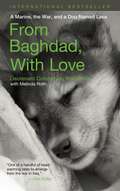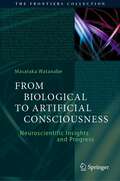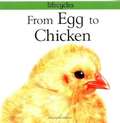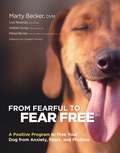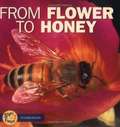- Table View
- List View
Frogs (Penguin Young Readers, Level 2)
by Laura DriscollCroak if you love frogs! Amazing amphibians leap from the pages of this easy nonfiction reader featuring incredible cut-paper frogs in every color, shape, and size.
Frogs (Readers)
by Elizabeth CarneyWHAT WAS THAT? That&’s the roaring burp of a bullfrog! SEE THAT? That&’s the slick, shiny skin of colorful little rainforest frogs! Alive with froggy facts, this book has the coolest photos to bring kids deep into the swampy world of our amphibian amigos.National Geographic supports K-12 educators with ELA Common Core Resources.Visit www.natgeoed.org/commoncore for more information.
Frogs (Seymour Simon Science Ser.)
by Seymour SimonAward-winning science writer Seymour Simon takes readers on a journey through a frog's life cycle, from egg to tadpole to grown frog in this engaging nonfiction picture book. Readers will learn about the different types of frogs and toads from all over the world! Where do frogs live? How do frogs eat and drink? How far can they jump? Find out and more in this beautiful picture book ideal for young scientists and animal-lovers filled with fascinating facts, stunning full-color photographs, and an underlying message of ecological preservation.. This book includes an author's note, a glossary, and an index. An excellent choice for classrooms and homeschooling, Frogs supports the Common Core State Standards.
Frogs and Other Amphibians (World Book's Animals of the World)
by Sheri RedaQuestion and Answers about frogs, toads, salamanders, newts and much more.
Frogs and Toads
by Bobbie Kalman Tammy EvertsWhat is the difference between a frog and a toad? Does touching a toad cause warts? Frogs and Toads answers children's questions using amazing natural photographs that leap right off the page.
Frogs and Toads (Animal Lives Series)
by Sally MorganFrom tadpoles to hopping and croaking--your total frog and toad guide Did you know that the glass frog has see-through skin so you can see its insides? Would you believe that the cane toad can grow to the size of a soccer ball? Discover everything you ever wanted to know about these incredible animals--where they live, how they grow and learn, and the dangers that they face. By the time you've finished reading, you'll be a frog and toad expert! Amazing facts and figures Stunning photographs of these creatures in action Locator maps to show where each animal can be found
Frogs of the United States and Canada
by C. Kenneth Dodd Jr.The most thorough, updated guide to frogs and toads in the United States and Canada available.A stunning diversity of frog species can be found from coastal swamps to lofty mountain peaks, and from the Florida Keys to the Arctic Ocean. They live in subtropical lowlands, grassland prairies, deserts, and alpine-tundra habitats. Some species have restricted habitat requirements, whereas others occur contiguously from the arid plains or humid southeastern forests to the high tundra. In this new edition of Frogs of the United States and Canada, C. Kenneth Dodd Jr. tours the reader through the marvelous world of North American frogs. Covering 114 native and introduced species from all US states and Canadian provinces, this comprehensive reference on the biology, behavior, and conservation of the Order Anura includes detailed and updated information on• past and present distribution • life history and demography • reproduction and diet• landscape ecology and evolution• diseases, parasites, and threats from toxic substances• conservation and management Hundreds of occurrence maps, line drawings, and new color photographs of frogs and their habitats enhance the text. The most thorough treatment of the life histories, distribution, and status of North American frogs ever produced, Frogs of the United States and Canada has been the go-to reference for naturalists, scientists, and resource managers in their efforts to understand and conserve frogs, their habitats, and biodiversity for over a decade. Based on a meticulously updated examination of more than 8,000 references current through 2021, this second edition ensures Dodd's master work will remain an unparalleled resource for years to come.
Frogs!
by Elizabeth CarneyWHAT WAS THAT? That's the roaring burp of a bullfrog! SEE THAT? That's the slick, shiny skin of colorful little rainforest frogs! Alive with froggy facts, this book has the coolest photos to bring kids deep into the swampy world of our amphibian friends.
Frogs!: Strange and Wonderful (Strange and Wonderful)
by Laurence PringleAre kids going to love this book? Is a frog waterproof? The latest title in the popular Strange and Wonderful series delivers the awe-inspiring variety of frogs, the world's hoppiest amphibians. Did you know that the Goliath frog is more than a foot long? Or that the tiny gold frog could sit on a dime? Some frogs have camouflage. Others wear bold colors warning their enemies that they are poisonous. Some frogs leap, others hop, one is a runner, and a few glide from tree to tree with their big, webbed hands and feet! Surprising facts and beautiful, realistic nature illustrations come together in this celebration of one of nature's most fascinating marvels.
Frogs: The Animal Answer Guide (The Animal Answer Guides: Q&A for the Curious Naturalist)
by Mike Dorcas Whit GibbonsFrogs are amazingly diverse—ranging from the massive goliath frog, which weighs several pounds, to the recently discovered gold frog, which measures a mere three-eighths of an inch when fully grown—and have inhabited the earth for more than 200 million years. Today, however, these amphibians face more challenges than any other vertebrate group. In this fun and informative book, herpetologists Mike Dorcas and Whit Gibbons answer common and not-so-common questions people may have about these fascinating animals.Dorcas and Gibbons discuss how frogs evolved, which species currently exist in the world, and why some have recently gone extinct. They reveal what frogs eat and what eats them, their role in cultures across the globe, why many populations are declining and what we can do to reverse this dangerous trend, why there are deformed frogs, and much more. They answer expected questions such as "What is the difference between a frog and a toad?" and "Why do some people lick toads?" and unexpected ones such as "Why do some frogs lay their eggs in the leaves of trees?" and "Do frogs feel pain?" The authors’ easy-to-understand yet thorough explanations provide insight into the amazing biology of this amphibian group. In addressing conservation questions, Dorcas and Gibbons highlight the frightening implications of the current worldwide amphibian crisis, which many scientists predict will bring extinction rates experienced by frog species to levels not seen in any vertebrate animal group in millions of years.Packed with facts and featuring two color galleries and 70 black-and-white photographs, Frogs: The Animal Answer Guide is sure to address the questions on the minds of curious naturalists.
From A to Bee: My First Year as a Beginner Beekeeper
by James DearsleyJames Dearsley’s wife thought he had lost his mind when he announced his intention to become a beekeeper. Like many interested in self-sufficiency, he loved gardening and growing vegetables and he wanted to teach his little boy where honey came from, so he set himself a goal: to get, in a year’s time, just one jar of honey.
From A to Bee: My First Year as a Beginner Beekeeper
by James DearsleyJames Dearsley’s wife thought he had lost his mind when he announced his intention to become a beekeeper. Like many interested in self-sufficiency, he loved gardening and growing vegetables and he wanted to teach his little boy where honey came from, so he set himself a goal: to get, in a year’s time, just one jar of honey.
From Abundance to Scarcity: A History Of U.S. Marine Fisheries Policy
by Michael L. WeberThe management of coastal and ocean fisheries is highly contentious. Industry interests focus on maximizing catches while conservationists and marine scientists have become increasingly concerned about dramatic declines in fish stocks and the health of ecosystems. Besides attempting to mediate among these interests, government agencies have pursued their own agendas, which have often lagged behind shifts in scientific understanding and public attitudes about the productivity of the oceans and uses of marine wildlife.From Abundance to Scarcity examines the evolution of US fisheries policy and institutions from the late 19th century to the present day, with an emphasis on changes since World War II. Based on archival research and interviews with dozens of key players in marine policymaking, it traces the thinking, legislation, mandates, and people that have shaped the various agencies governing fisheries in the United States. The book discusses the development of federal programs in marine biological sciences and the evolution of scientific understanding about marine wildlife populations; describes the work of federal fisheries programs; considers the response of agencies to factors such as dam-building and coastal development that have led to increased pollution and habitat loss; examines the shifts in understanding and values that underlie major legislation; and examines the evolving relationship between federal agencies, the fishing industry, communities, and nongovernmental conservation organizations.From Abundance to Scarcity sheds light on the sets of interests that have shaped US fisheries policy, lending historical depth to current debates and providing a fuller understanding of current laws and regulations. It offers an insightful overview for professionals involved with fisheries management or the fishing industry, conservationists working on marine issues, and students of marine, environmental, or public policy.
From Animals to Animats 14
by Elio Tuci Alexandros Giagkos Myra Wilson John HallamThis book constitutes the proceedings of the 14th International Conference on Simulation of Adaptive Behavior, SAB 2016, held in Aberystwyth, UK, in August 2016. The 31 papers presented in this volume were carefully reviewed and selected from 45 submissions. They cover the main areas in animat research, including the animat approach and methodology, perception and motor control, learning and adaptation, evolution, and collective and social behavior.
From Baghdad to America: Life Lessons from a Dog Named Lava (Playaway Adult Nonfiction Ser.)
by Jay KopelmanLieutenant Colonel Jay Kopelman won the hearts of readers everywhere with his moving story of adopting an abandoned puppy named Lava from a hellish corner of Iraq. He opened the door for other soldiers to bring dogs home, and in From Baghdad to America, Kopelman once again leads the pack with his observations on the emotional repercussions of war. Here, for the first time, Kopelman holds nothing back as he responds to the question, "Why did you save a dog instead of a person?" The answer reveals much about his inner demons-and about the bigger picture of Operation Iraqi Freedom. He talks about what it's like to return to the States and examines the shocking statistics to come out of Iraq: Depression, suicide, alcohol abuse, and broken relationships are at record highs for the men and women who serve there. Kopelman credits Lava with helping him to endure combat and the pain of war, as well as helping him deal with the surprising difficulties of returning to everyday life. Civilians have a hard time understanding what being a Marine means, and the adjustment to living among them is hard for these soldiers. This book attempts to shed light on that for all readers.
From Baghdad, with Love: A Marine, the War, and a Dog Named Lava
by Jay Kopelman Melinda RothWhen Marines enter an abandoned house in Fallujah, Iraq, and hear a suspicious noise, they clench their weapons, edge around the corner, and prepare to open fire. What they find during the U.S.-led attack on "the most dangerous city on Earth" in late 2004, however, is not an insurgent but a puppy left behind when most of the city's residents fled. Despite military law forbidding pets, the Marines de-flea the pup with kerosene, de-worm him with chewing tobacco, and fill him up on Meals Ready to Eat. Thus begins the dramatic rescue of a dog named Lava and Lava's rescue of at least one Marine, Lieutenant Colonel Jay Kopelman, from the emotional ravages of war. From hardened soldiers to wartime journalists to endangered Iraqi citizens,From Baghdad, With Love tells the unforgettable true story of an unlikely band of heroes who learn unexpected lessons about life, death, and war from a mangy little flea-ridden refugee.
From Biological to Artificial Consciousness: Neuroscientific Insights and Progress (The Frontiers Collection)
by Masataka WatanabeHow does consciousness emerge from a brain that consists only of physical matter and electrical / chemical reactions? The deep mysteries of consciousness have plagued philosophers and scientists for thousands of years. This book approaches the problem through scientific studies that shed light on the neural mechanism of consciousness, and furthermore, delves into the possibility of artificial consciousness, a phenomenon that may ultimately solve the mystery. Finally, two key suggestions made in the book, namely, a method to test machine consciousness and a theory hypothesizing that consciousness emerges from a neural algorithm, reveal a novel and credible pathway to mind-uploading.The original Japanese version of this book has become a best-seller in popular neuroscience and has even led to a neurotech startup for mind-uploading.
From Caterpillar To Butterfly (Let's Read And Find Out Ser.)
by Deborah Heiligman Bari WeissmanAfter a caterpillar comes to school in a jar, the children are captivated as it eats, grows, and eventually becomes a beautiful Painted Lady butterfly. This title features colorful illustrations from veteran illustrator Bari Weissman and lively text from National Book Award finalist and Michael L. Printz Honor winner Deborah Heiligman. Now rebranded with a new cover look, this NSTA/CBC Outstanding Science Trade Book includes web research prompts and an activity encouraging kids to identify the different types of butterflies all around them. Both text and artwork were vetted for accuracy by Dr. Louis Sorkin, Senior Scientific Assistant at the American Museum of Natural History. This is a Level 1 Let's-Read-and-Find-Out, which means the book explores introductory concepts for children in the primary grades and supports the Common Core Learning Standards and Next Generation Science Standards. Let's-Read-and-Find-Out is the winner of the American Association for the Advancement of Science/Subaru Science Books & Films Prize for Outstanding Science Series.
From Caterpillar to Butterfly (Let's-Read-and-Find-Out Science 1)
by Deborah HeiligmanRead and find out about how a caterpillar becomes a butterfly in this colorfully illustrated nonfiction picture book.After a caterpillar comes to school in a jar, the children are captivated as it eats, grows, and eventually becomes a beautiful Painted Lady butterfly.This is a clear and appealing environmental science book for early elementary age kids, both at home and in the classroom. Plus it includes web research prompts and an activity encouraging kids to identify the different types of butterflies all around them.This is a Level 1 Let's-Read-and-Find-Out, which means the book explores introductory concepts perfect for children in the primary grades. The 100+ titles in this leading nonfiction series are:hands-on and visualacclaimed and trustedgreat for classroomsTop 10 reasons to love LRFOs:Entertain and educate at the same timeHave appealing, child-centered topicsDevelopmentally appropriate for emerging readersFocused; answering questions instead of using survey approachEmploy engaging picture book quality illustrationsUse simple charts and graphics to improve visual literacy skillsFeature hands-on activities to engage young scientistsMeet national science education standardsWritten/illustrated by award-winning authors/illustrators & vetted by an expert in the fieldOver 130 titles in print, meeting a wide range of kids' scientific interestsBooks in this series support the Common Core Learning Standards, Next Generation Science Standards, and the Science, Technology, Engineering, and Math (STEM) standards. Let's-Read-and-Find-Out is the winner of the American Association for the Advancement of Science/Subaru Science Books & Films Prize for Outstanding Science Series.
From Clone to Bone
by Robert J. Asher Johannes MüllerSince the 1980s, a renewed understanding of molecular development has afforded an unprecedented level of knowledge of the mechanisms by which phenotype in animals and plants has evolved. In this volume, top scientists in these fields provide perspectives on how molecular data in biology help to elucidate key questions in estimating paleontological divergence and in understanding the mechanisms behind phenotypic evolution. Paleobiological questions such as genome size, digit homologies, genetic control cascades behind phenotype, estimates of vertebrate divergence dates, and rates of morphological evolution are addressed, with a special emphasis on how molecular biology can inform paleontology, directly and indirectly, to better understand life's past. Highlighting a significant shift towards interdisciplinary collaboration, this is a valuable resource for students and researchers interested in the integration of organismal and molecular biology.
From Egg to Chicken (Lifecycles Series)
by Gerald LeggLarge illustrations and simple text describe what an egg is made of and how it hatches into a chicken.
From Fearful to Fear Free: A Positive Program to Free Your Dog from Anxiety, Fears, and Phobias
by Marty Becker Lisa Radosta Mikkel BeckerAlmost every dog owner has a pet who suffers from fear, anxiety, and stress (FAS). They are the underlying cause of many concerning behaviors such as excessive barking, aggression, destructive behaviors, and house-soiling. They are also the source for deterioration of the human-animal bond, and can make a trip to the veterinarian, pet groomer, or boarding facility miserable for pet and owner alike. Left untreated, these negative experiences can lead to devastating consequences and permanent damage. Unfortunately, many well-meaning owners misinterpret or overlook the often subtle signs of emotional injury and turmoil, or think that the pet will simply "outgrow" it. This leads to unnecessary trauma and suffering. Common FAS triggers include: Trips to the veterinarian (even for routine services such as vaccinations and nail trims) Bath time, brushing, or cleaning ears.Loud noises; thunderstorms; fireworks; the vacuum cleaner; construction; gunshots; or even buzzers on appliances. Less-familiar people or animals encountered on walks or near the home.Being left alone during work hours or even for short errands.Travel, including car rides. Finally, there's help. From Fearful to Fear Free is based on the groundbreaking Fear Free program embraced by tens of thousands of veterinary healthcare professionals and hundreds of thousands of pet owners (fearfreepets.com and fearfreehappyhomes.com). This is the first and most authoritative book on the subject of reducing FAS and increasing "happy and calm" in dogs. Since pets communicate nonverbally, this book will help you recognize if your pet is suffering from FAS. By knowing your dog's body language, vocalizations, and changes in normal habits, you can make an accurate diagnosis and take action to prevent triggers or treat the fallout if they do happen. You'll learn: The most effective prescription sedatives for keeping dogs calm and happy during thunderstorms, fireworks, and other stressful events. The positive steps you can take to keep your pet occupied, calm, and content while you're away at work or play.Simple, practical tactics for helping your dog learn to love going to the veterinarian's office—literally pulling you into the practice instead of avoiding it!How to easily groom your dog and give him medication.Tips to tame the chaos when guests arrive in your home or when your dog encounters other dogs and people on walks. Ways to tackle some of the common behavior issues that often have a root cause of FAS, while also improving your communication and bond with your pet. The three veterinary coauthors and one highly respected pet trainer have a combined 88 years of experience in the trenches of veterinary medicine, with specialties in behavior and training. By using their cutting-edge techniques, you'll have pets that are happier, healthier and live a longer, fuller life.
From Flower to Honey (Start to Finish)
by Robin NelsonSTART TO FINISH. HOW IS HONEY MADE? 1 Flowers open. 2 Bees fly to the flowers. 3 Bees drink nectar. What happens next? Read this book to find out!
